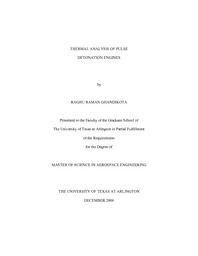
ATTENTION: The works hosted here are being migrated to a new repository that will consolidate resources, improve discoverability, and better show UTA's research impact on the global community. We will update authors as the migration progresses. Please see MavMatrix for more information.
Show simple item record
| dc.contributor.author | Ghandikota, Raghu Raman | en_US |
| dc.date.accessioned | 2009-09-16T18:20:13Z | |
| dc.date.available | 2009-09-16T18:20:13Z | |
| dc.date.issued | 2009-09-16T18:20:13Z | |
| dc.date.submitted | January 2008 | en_US |
| dc.identifier.other | DISS-10090 | en_US |
| dc.identifier.uri | http://hdl.handle.net/10106/1833 | |
| dc.description.abstract | The pulse detonation engine (PDE) is a compact system that can be modeled thermodynamically by the Humphrey cycle and is capable of high efficiency. The rapid heat release for stochiometric fuel/oxidizer ratios results in developing high temperatures. The high temperatures produced during its operation can cause the engine to fail. Thus, operating this engine for a longer duration would become dubious if the temperatures are not dissipated from it. The current research aims to perform a preliminary thermal analysis. This analysis consists of two steps. The first step is to determine the heat dissipated from the engine using the unsteady state analysis, and the second step is to develop a preliminary heat exchanger design. A design method is developed and an example design of a heat exchanger is proposed. | en_US |
| dc.description.sponsorship | Wilson, Donald R. | en_US |
| dc.language.iso | EN | en_US |
| dc.publisher | Aerospace Engineering | en_US |
| dc.title | Thermal Analysis Of Pulse Detonation Engines | en_US |
| dc.type | M.S. | en_US |
| dc.contributor.committeeChair | Wilson, Donald R. | en_US |
| dc.degree.department | Aerospace Engineering | en_US |
| dc.degree.discipline | Aerospace Engineering | en_US |
| dc.degree.grantor | University of Texas at Arlington | en_US |
| dc.degree.level | masters | en_US |
| dc.degree.name | M.S. | en_US |
| dc.identifier.externalLink | http://www.uta.edu/ra/real/editprofile.php?onlyview=1&pid=268 | |
| dc.identifier.externalLinkDescription | Link to Research Profiles | |
Files in this item
- Name:
- Ghandikota_uta_2502M_10090.pdf
- Size:
- 7.610Mb
- Format:
- PDF
This item appears in the following Collection(s)
Show simple item record


